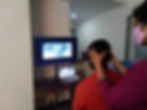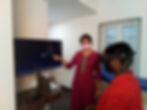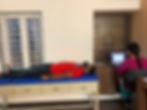
SERVICES
Your well being is at the core of our practice
Our team is brought together by the common goal of providing the best possible care and treatment to their patients with hearing problems. BHII brings together a multidisciplinary team of ENT surgeons, Audiologists, Speech & Language Pathologists, and other support staff who provide innovative, individually tailored treatments for all types of hearing, speech, voice & language disorders. The team will ensure the best standard of care and infrastructure in our centre and all our affiliated hospitals.



















Auditory Brainstem Implants
The Auditory Brainstem Implant is a more recent development that provides rehabilitation to individuals who do not benefit even with cochlear implants. Although it looks similar to the cochlear implant externally, the electrode is placed directly on the cochlear nucleus, stimulating the neural auditory pathways in the brainstem. Recent advances in technology have broadened the candidacy for auditory brainstem implants, which means that essentially people of almost all age groups have access to a solution for neural hearing losses.

Tinnitus Evaluation and Management
Tinnitus is an auditory disturbance in the ear that can be heard as ringing, buzzing, roaring, or clicking sounds depending on the individual's condition. It is a symptom of a variety of hearing conditions, and may be present in one or both ears. Most often, the cause of tinnitus is hearing loss, which can be managed by the use of hearing aids as it compensates for the lack of hearing. Tinnitus maskers and tinnitus retraining therapy are two other management options that train people to become habituated to their tinnitus.

Tinnitus Evaluation and Management
Tinnitus is an auditory disturbance in the ear that can be heard as ringing, buzzing, roaring, or clicking sounds depending on the individual's condition. It is a symptom of a variety of hearing conditions, and may be present in one or both ears. Most often, the cause of tinnitus is hearing loss, which can be managed by the use of hearing aids as it compensates for the lack of hearing. Tinnitus maskers and tinnitus retraining therapy are two other management options that train people to become habituated to their tinnitus.

Cochlear Implants
Cochlear implants have developed drastically in the past few decades, helping a large number of individuals with severe to profound hearing losses. Unlike conventional hearings aids, cochlear implants do not simply amplify sound. Instead, it bypasses the damaged or non-functioning inner ear to directly stimulate the auditory nerve. Our multidisciplinary team combines the expertise of leading professionals with the latest available technology to provide the best pre- and post surgical management. Research has shown that early intervention combined with auditory verbal therapy post surgery produces positive hearing outcomes, including integration into mainstream education.

Audiological Assessment
For hearing evaluation, an audiologist employees various subjective and objective diagnostic tests. Pure Tone Audiometry (PTA) uses single frequency "pure tones" and Speech Audiometry assesses an individual's ability to identify and repeat speech stimuli. The findings of both tests can help diagnose the type and severity of hearing loss. Behavioral Observation (BOA) of the child's responses provides an informal baseline of the level of the child's hearing. Newborns and young children are unable to participate in subjective hearing tests.and require objective measures for assessment and diagnosis. Tympanometry or Impedance Audiometry assess the middle ear functioning and the movement of the eardrum by varying the air pressure in the ear canal. Otoacoustic Emissions (OAE) test checks the hair cells in the cochlea and how they respond to a series of sound stimulation. Brainstem Evoked Response Audiometry (BERA) is another objective test that assess the auditory pathway from the inner ear to the auditory areas in the brainstem in response to various acoustic stimuli. A BERA test can be used for the diagnosis of cochlear and neural hearing losses.

Voice Therapy
Voice Disorders include problems in the adequate production of voice in terms of pitch, volume, or quality. Management of voice disorders involve speech language pathologists using multiple therapeutic approaches to develop an effective treatment plan. It included a combination of direct and indirect approaches based on therapy goals. Direct approaches involve manipulation of vocal mechanisms for healthy voice production, while indirect approaches focus on modifying the environmental aspects in which the voice is produced.

Active Middle Ear Implants
Active middle ear implants are alternatives to amplification devices that covert sound into vibrations. The implant works by either moving the middle ear ossicles or by acoustic stimulation of the cochlear round window. These vibrations can be adjusted according to the type and degree of hearing loss. Middle ear implants can eliminate some of the issues caused by hearing aids such as excessive occlusion, over amplification of background noise and sound distortion.

Bone Anchored Hearing Aids
Individuals with outer ear malformations, chronic middle ear infections, and unilateral hearing losses are either unable to wear conventional hearing aids, or they do not benefit from them. The bone anchored hearing implants bypass outer and middle ear functions to transmit the sound to the working cochlea via bone conducted vibrations. This direct bone conduction allows the user to hear more naturally. One of the biggest advantages of a BAHA is that potential candidates can try the device with a soft band in order to experience the benefits before undergoing the surgical procedure.

Vertigo & Balance Assessment
Vertigo is a feeling of imbalance and dizziness. Most often, Vertigo is a symptom of another underlying condition rather than an independent disorder. Vertigo can be either peripheral or central in origin. During episodes of vertigo, individuals may experience rapid and abnormal eye movements, known as nystagmus. Tests such as Vestibular Evoked Myogenic Potentials (VEMP) and Video Nystagmography (VNG) are diagnostic tools that help determine the cause and nature of vertigo.

Hearing Aids
Hearing loss can have a major impact on multiple aspects of life. Hearing Aids can make a huge difference, provided that you choose the appropriate ones and are well programmed. A hearing aid is an electronic device that can either be worn behind your ear or in the ear canal designed to amplify sounds. Hearing aids come in a variety of models and ranges and an audiologist will suggest devices based on your audiogram and personal requirements.

Adult Neuro-rehab & Swallowing
Acquired disorders in adults include cognitive-communication and speech disorders that result in memory issues, slurring of speech, weak oral muscles, communication and listening difficulties secondary to neurological issues. In such cases, treatment goals focus on preventing further degeneration of memory, strategies to improve coherent speech for communication, strengthening oral-facial muscles, or introducing aided communication plans.
Swallowing is a complex action that requires coordination of the mouth, tongue, palate and esophagus, lack of which will cause difficulties in swallowing. Management of swallowing includes compensatory strategies to improve control over swallowing to prevent aspiration along with direct treatment techniques such as exercises to improve overall range of motion and strength of oral muscles.
%20(1).png)